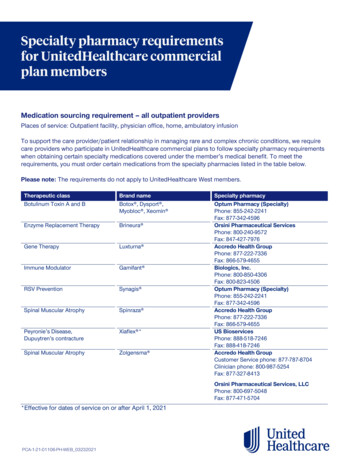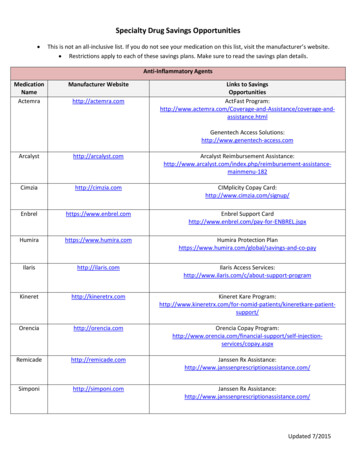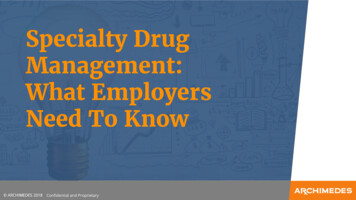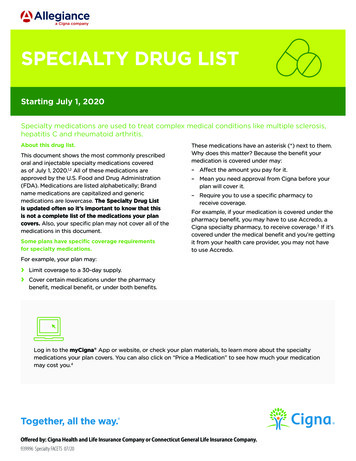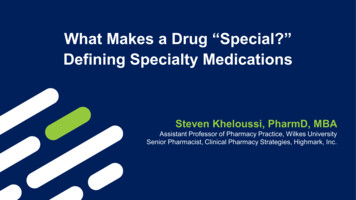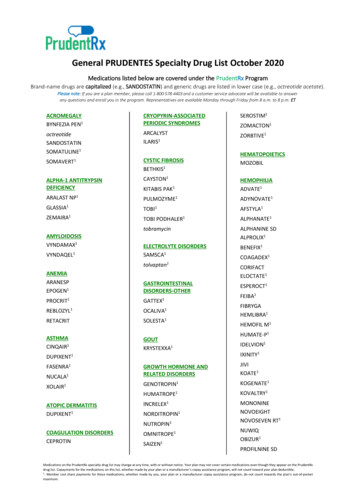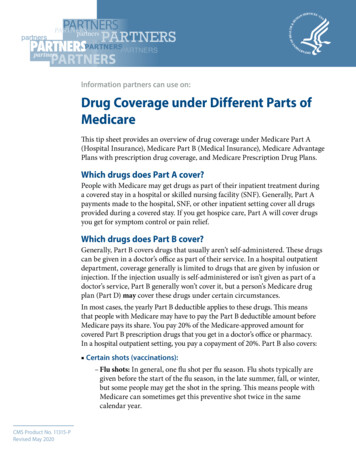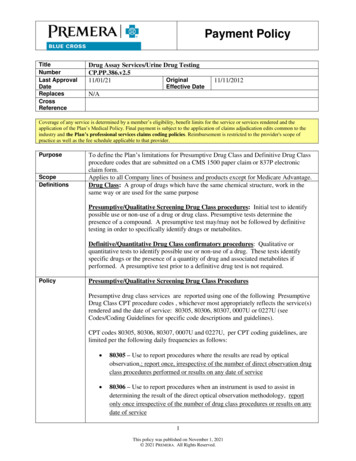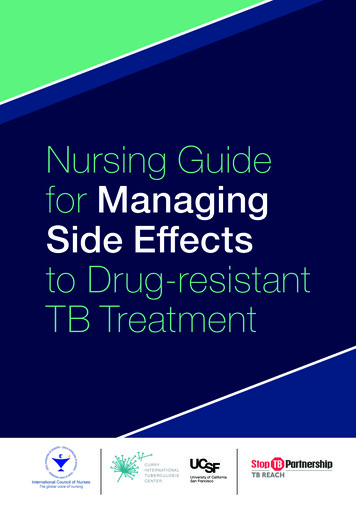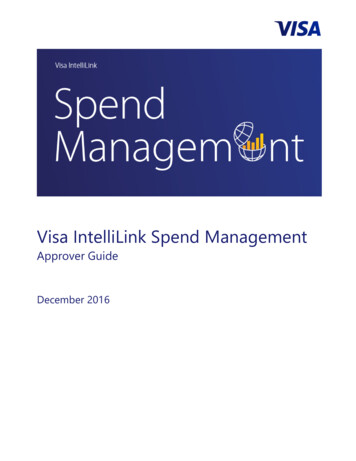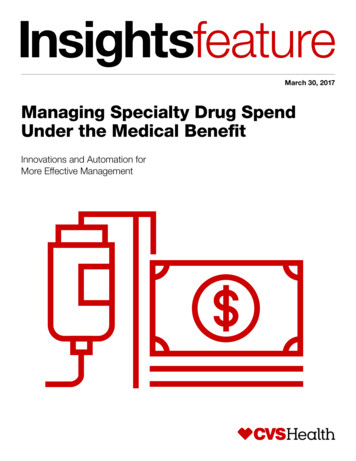
Transcription
InsightsfeatureMarch 30, 2017Managing Specialty Drug SpendUnder the Medical BenefitInnovations and Automation forMore Effective Management
The Less-Visible Part of Specialty SpendBy most estimates, specialty spend under the pharmacybenefit represents a little more than half of total specialtyspend. Payors spend almost the same amount onspecialty drugs administered under the medical benefit.1Drugs that are injected or infused in a medical setting(such as a doctor’s office or outpatient hospital facility)are customarily billed under the medical benefit. Weanticipate that as overall specialty spend grows fromabout a third of total drug spend to more than half by2020, this ratio will remain about the same.Every payor knows that managing specialty drugs ismore complex than managing traditional pharmaceuticals.It’s not just that they cost more than traditional drugsand often treat highly complex, life-altering conditions.Specialty patients’ conditions, clinical care and overallmanagement tend to be more complex.What’s more, the robust pipeline, expanding numberof conditions treated by specialty drugs, and evolvingregulations pose particular challenges for payors. Asnew therapies are approved, treatment for an increasingnumber of conditions involves a combination of drugs,some of which are paid under the pharmacy benefit andsome of which are paid under the medical benefit, furthercomplicating management and potentially fragmentingpatients’ care.Nearly Half of Specialty Spend is Administered Under the Medical Benefit55%under thepharmacy benefitTotal spend onspecialty pharmaceuticals45%under themedical benefitManagement is further complicated becausetreatment for an increasing number of conditionsinvolves a combination of drugs, some of which arepaid under the pharmacy benefit and some underthe medical benefit.
Added Challenges of Medical Benefit ManagementManagement of specialty drugs under the medical benefit often requiresdealing with additional layers of complexity and costs and can furtherdrive up spending. Medical claims for drugs have several shortcomingswhen compared with pharmacy claims:Limited visibility into drug spend: Medical claims are traditionallybilled with health care procedure codes (also known as HCPCs and oftenreferred to as J-codes). Tracking and evaluating the precise amounts forsome drugs billed and paid under the medical benefit with HCPCs is moredifficult than doing so with the codes used on pharmacy claims (uniqueproduct identifiers for drugs known as National Drug Codes or NDCs).There are several reasons why J-codes present visibility challenges. Somedrugs do not have a specific code assigned and may be billed under anunspecified or miscellaneous code. Some J-codes may apply to manydifferent drugs (so called “one-to-many relationship”). Finally, incorrectbilling is not uncommon, and it can cause problems when payments aremade later on.Fewer checks and balances: Claims managed under the pharmacybenefit have built-in processes to help ensure evidence-based utilizationand the use of cost-effective medications. Under the medical benefit,however, such checks and balances are much less common. The onlyclinical data required for medical claims is diagnosis, which provideslimited opportunities for management.Lack of automation: Both prior authorization (PA) and claims processingare generally less automated and streamlined under the medical benefit,which can still rely heavily on faxes and phone calls.Timeliness of claims: Medical claims data lags the actual serviceand is usually not available for days to weeks, after a patient sees aprovider, or after the patient has received the medication. Pharmacyclaims are processed in near real-time, prior to the patient actuallyutilizing the medication.
Better Data Equals Better Opportunities for ManagementBetter data, acquired through PA, translates into bettermanagement of both cost and care. While medicalclaims provide some detailed data and insights, thedrawback is the lag time in obtaining data. Pharmacyclaims provide very similar, relevant data including patientdemographics, drug name or code, and diagnosis, whichis inferred on the pharmacy claims.We offer automated PA and claims management acrossbenefits, which provides a host of tools to facilitate moreeffective management for both payors and providers.Our proprietary cross-benefit PA technology capturesdiagnosis, rather than simply the drug, to infer diagnosis,as well as clinical exam and lab data and response tocurrent therapy, as a condition of coverage before thedrug is administered. This data can then be used tosupport a variety of management programs, includingrebates for pharmacy and medical claims, addressingthe needs of both the plan and the provider.Prior Authorization Across Benefits Provides Richest,Most Timely Data Set to Manage Specialty Drug CostsData SourceTypical TimingData ProvidedMedical ClaimDays to weeks afterdrug administration Patient demographics Drug code Diagnosis Billed procedureUsually a dayafter service Patient demographicsPrior to drugadministration Patient demographics Clinical exam data Diagnosis Lab data Prescribed drug Response to therapyPharmacy ClaimPA Across Benefits Drug code Diagnosis (inferred)Automated PA Across Benefits:Allows the provider to log in through theplan’s portal and establish the patient’seligibility with a single sign onSupports the use of lesscostly formulary alternatives,including biosimilars,in alignment with planobjectives and prioritiesIntegrates the plan’s rules for the specificmedication to support appropriate andcost-effective prescribing practicesFacilitates the PAprocess for providerswhile helping payorssave time and moneySupports moresophisticated reportingand greater visibilityinto therapy progress
Ensure Claims Match the PA and Are Paid AppropriatelyProvider administration of drugs can occur in the hospital,hospital outpatient, physician office, ambulatory infusionsuite or in the home. Billing and reimbursement vary bysite of care, with hospitals often basing reimbursementon a percent of charges. Most other sites base billingon average sales price (ASP) plus a percentage. Suchdifferences in reimbursement methodology can result inwide disparities in costs. Moreover, submitted claims mayreflect that the units of drug administered and/or billeddeviate from recommended dosages. All these factorscomplicate management for payors.To help with this challenge, CVS Health has proven,in-market claims management technology. The chartbelow illustrates a case study of Remicade claims assubmitted and edited. The x axis shows the submitteddose — what the doctor or clinic wanted to be paid.The y axis represents the edited number of units basedon clinical review — the adjusted amount for which theprovider was actually paid. In this case study, our editingprocess validated that 11 percent of claims submittedexceeded the recommended dose. Of those, 79 percentwere clinically inappropriate. These claims were adjustedresulting in a 33 percent savings.Remicade Claims As Submitted and After Editing200180pp ro160140As Edited120,atepri woriepap revally afterciclin ored ttedem ubmieD ssaDosing thresholdvaries by indication1008060ally tenicCli ropriapap40Der iaFor this claim thesubmitted amountwas 180 units, asshown on the x axis,and the post-editpaid number of unitswas 90 units, asshown on the y axis.teapllyca eviewinicl r red afteemClaims paidas submittedSubmitted amount reduced toclinically appropriate level20Claims paidafter being edited0020406080100120140160180200As Submitted11%of submitted claimsexceeded recommendeddosages79%of those were clinicallyinappropriate33%saved onedited claimsSource: CVS Health internal Data, 2016.Using this platform we can also help ensure that claims submitted matchthe drug and dose that was approved in the PA process
Additional Layer of Management: Site of CareAdministration of specialty drugs under the medicalbenefit may occur in several different settings. Whenappropriate, infusion in the home or in an infusion centercan provide an additional layer of management andgreater predictability in billing. According to one survey,nearly half of payors plan to guide members away fromhospital outpatient sites to alternate facilities.With its own infusion network and home infusion services,CVS Health may be able to facilitate infusion in these orother alternate sites, including working with patients toease transitions. Many members welcome the transitionsince these alternate sites can offer greater convenience.We are also enhancing our PA systems to facilitatemore intensive site-of-care management for payors andproviders, guiding patients to the most cost-effective sitesas early in therapy as possible. This seamless process isautomated through technology, and supported by medicalnecessity and our dedicated, centralized site-of-care team.Hospital CareOutpatient Infusion FacilityNearly half of payors plan to guidemembers away from hospitaloutpatient facilitiesHome CareMany members welcome thetransition as more convenient
Looking AheadAs specialty products target more common conditions,and utilization and costs increase, managementchallenges will only become more pronounced. Anincreasing number of conditions can be treated with arange of specialty drugs, including drugs billed underboth the pharmacy and medical benefits. This numberwill continue to grow. The specialty pipeline remainsrobust, and we project that more than a third of potentialproducts are likely to be administered under the medicalbenefit, making it imperative that payors developstrategies to optimally manage this spend.As we have discussed, specialty management modelsare evolving. The CVS Health model – an integratedpharmacy benefit manager (PBM) and specialtypharmacy with retail access, as well as embeddedcare management – brings together a broad range ofcapabilities and assets to help our clients manage theirspecialty pharmacy spend.CVS Health has the broadest set of integrated capabilitiesto help manage specialty spend under both benefits.Our medical benefit management solutions help to bringpharmacy precision and control to management of thisspend, and we continue to innovate and add new layersof sophistication to our approach. Current areas of focusinclude Medicare Part B PA delegation and rebates ondrugs adjudicated under the medical benefit.Our goal is to provide maximum value to payors, while helpingto improve the physician experience and member outcome.Alan Lotvin, MDExecutive Vice President, CVS Specialty Pharmacy1. Data Source: Medicines Use and Spending in the U.S. IMS, April 2016. NHE, Artemetrx, CVS Health Internal Analysis, 2016.Projections based on CVS Health data. Individual results will vary based on plan design, formulary status, demographic characteristics and other factors.Client-specific modeling available upon request.This document contains references to brand-name prescription drugs that are trademarks or registered trademarks of pharmaceutical manufacturers not affiliated with CVS Health.CVS Health uses and shares data as allowed by applicable law, our agreements and our information firewall.
You can subscribe to Insights by emailingInsights@cvscaremark.com 2017 CVS Health. All rights reserved. 106-40766A1 033017
We offer automated PA and claims management across benefits, which provides a host of tools to facilitate more effective management for both payors and providers. Our proprietary cross-benefit PA technology captures diagnosis, rather than simply the drug, to infer diagnosis, as well as cl

